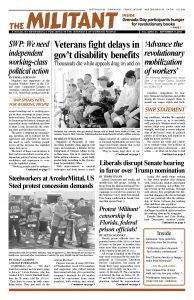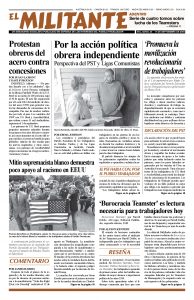 SAN FRANCISCO — Supporters of the fight to end solitary confinement of inmates in California state prisons rallied outside the federal courthouse here Aug. 21. Their action was in solidarity with four prisoners — Todd Ashker, Arturo Castellanos, George Franco and Sitawa Nantambu Jamaa — who have helped lead the ongoing struggle against the barbaric policy. They were in a court-ordered meeting with representatives of the California Department of Corrections inside the building.
SAN FRANCISCO — Supporters of the fight to end solitary confinement of inmates in California state prisons rallied outside the federal courthouse here Aug. 21. Their action was in solidarity with four prisoners — Todd Ashker, Arturo Castellanos, George Franco and Sitawa Nantambu Jamaa — who have helped lead the ongoing struggle against the barbaric policy. They were in a court-ordered meeting with representatives of the California Department of Corrections inside the building.
The four were central leaders of hunger strikes and protests that grew to include 30,000 prisoners at the high point in 2013. These actions put a national spotlight on the abuse of thousands of prisoners held, some for decades, with little human contact in 8- by 10-foot windowless Security Housing Unit cells known as the SHU.
The four were also plaintiffs in a suit — Ashker vs. Governor of California — that won an end to indeterminate-length sentences to solitary confinement in California and the release of over 1,400 prisoners from the SHU.
Despite the success of moving some to general population units, the fight is far from over. Many of those released from the SHU have been transferred to extremely restrictive conditions in Level IV prisons or in Restricted Custody General Population Units, which have conditions markedly similar to that in the SHU.
“Our fight is against solitary confinement, no matter what they call it or what forms it takes,” Marie Levin, sister of Sitawa Nantambu Jamaa, told rally participants. She pointed to a giant banner held by protesters saying, “END ALL FORMS OF SOLITARY CONFINEMENT.”
Letters from prisoners held in Level IV and Restricted Custody Units were read aloud, describing the denial of social interaction with fellow prisoners and lack of educational and job-training programs.
Anne Weills, an attorney in the lawsuit, said the prisoner representatives are demanding Todd Ashker, who was thrown back in isolation after being held for over three decades in solitary in the SHU at Pelican Bay, be released to the general population.
Jamaa and other veterans of the struggle have also experienced retaliation, including being returned to solitary on trumped-up charges. These frame-ups and isolation are aimed at “our peaceful efforts to effect genuine changes,” Jamaa wrote in an article run March 26 in the San Francisco Bay View.
Ashker v. Governor of California was filed in 2012 by the inmates with attorneys from the Center for Constitutional Rights. After the hunger strikes, state prison officials settled on Sept. 1, 2015. The results are monitored by Judge Claudia Wilken of the Northern District Court.
In July, Wilken ruled that California prison authorities were not complying with the settlement and ordered the meeting held Aug. 21.
Any gains won in this fight are due to the conduct of the prisoners themselves, said Laura Magnani, an activist with the Prisoner Hunger Strike Solidarity Coalition, which organized the protest “to their vision, courage, and persistence.”
Fundamental to this has been the unity between prisoners of different races and origins forged in the struggle. “Our current collective movement began in the bowels of Pelican Bay State Prison — SHU — Short Corridor, wherein prisoners of all races and various geographical areas became openly conscious of what we had in common — rather than what was different (divisive),” Ashker wrote last year.
In 2012, the Short Corridor Collective released an “Agreement to End Race-Based Hostilities” that called for an end to violence among prisoners. Ashker said the prison authorities’ efforts to pit prisoners against each other was “the source of our mutual adversary’s manipulation tactics — centered on keeping us divided and violent towards one another.”
“We must stand together not only for ourselves, but for future generations of prisoners,” the four prisoners said in a joint statement in 2017 reaffirming the agreement, “so that they don’t have to go through the years of torture we had to.”



